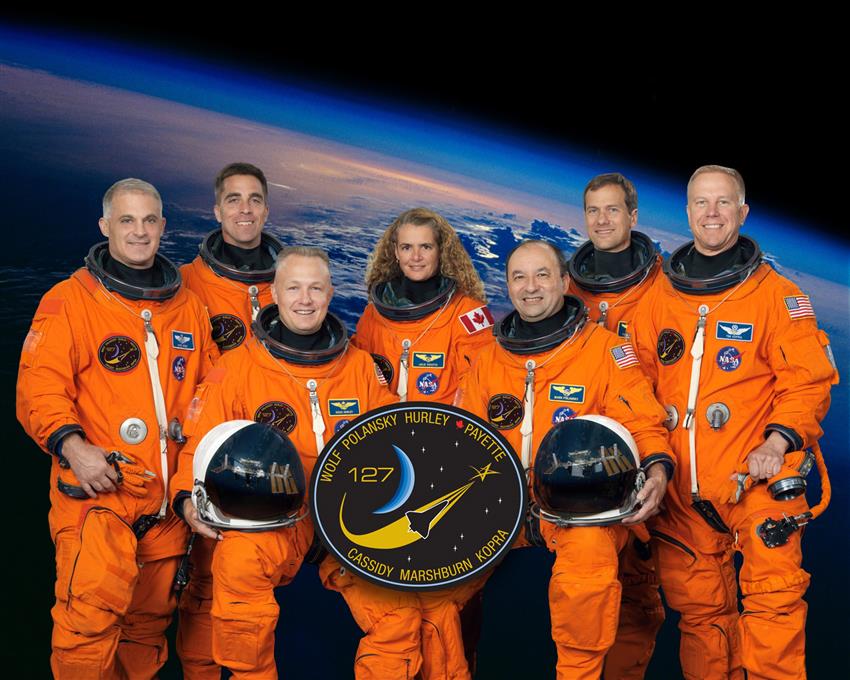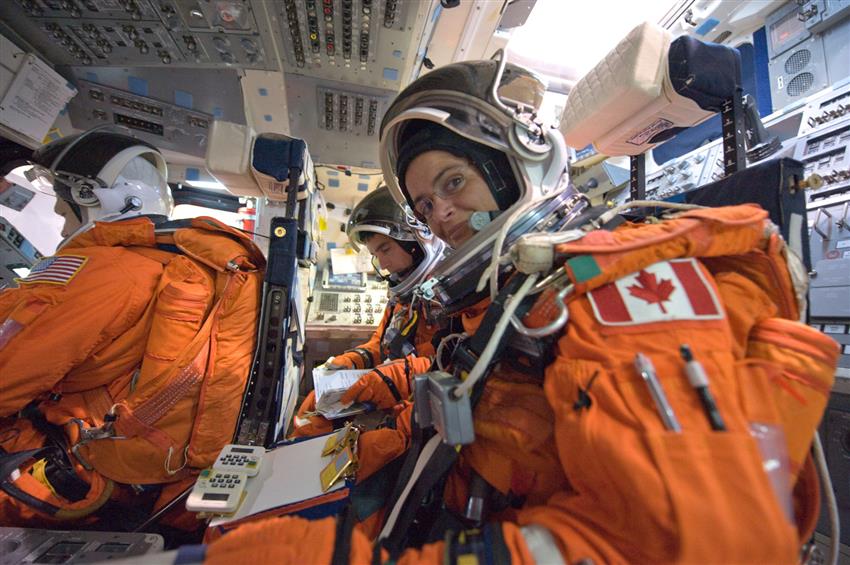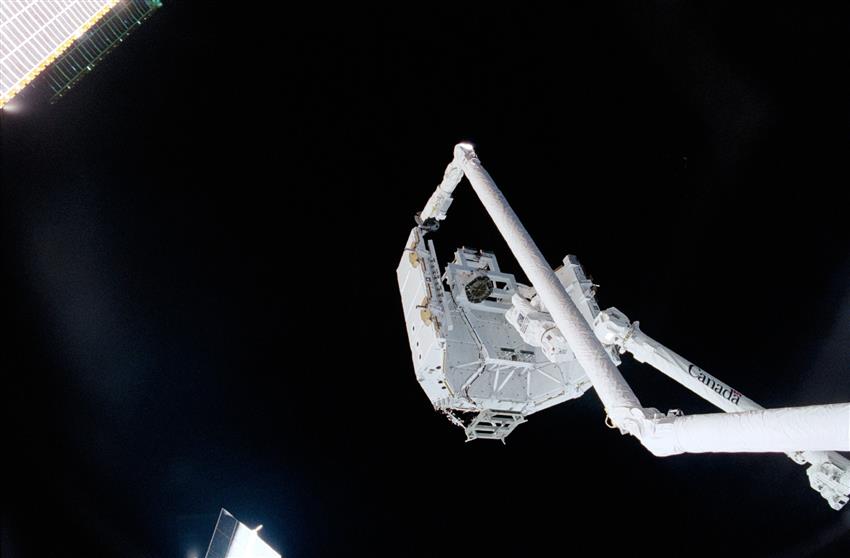Mission STS-127

Mission description

Text version
This patch commemorates Julie Payette's second spaceflight and her participation as mission specialist on mission STS-127 to the International Space Station (ISS).
The central element is the Earth seen from space, in all its magnificent beauty.
The arm comprised of bold electronic circuitry, represents the strength of Canadian space technology including space robots like Canadarm2 and Dextre. The circuitry spelling out Julie Payette's name reflects her background in electrical and computer engineering, as well as her role as flight engineer and robotics operator on the mission.
The shining stars embody the six other mission crew members.
It is however, the Earth that captures our ultimate attention. Space exploration provides humanity with a unique and privileged vantage point of our blue planet, reminding us that we must work together to preserve our shared home. Humanity's symbiotic relationship with Earth is reflected in the hand gently curved toward our planet.
Patch STS-127. (Credit: Canadian Space Agency)
Launch
Date: July 15, 2009
Time: 6:03:10 p.m. ET
Landing
Date: July 31, 2009
Time: 10:48:08 a.m. ET
Site: Kennedy Space Center
Mission duration: 15 days 16 h 44 min 58 s
Flight number: STS-127
Orbiter vehicle: Endeavour
The cosmic stage was set for a new era in Canadian space exploration and scientific research aboard the International Space Station (ISS) when Space Shuttle Endeavour launched on flight STS-127. Endeavour and her crew of seven, including veteran Canadian astronaut Julie Payette, launched on July 15, 2009 and were undertaking a 16-day mission that included days of demanding construction work on the largest and most complex space project in the history. Endeavour hauled a cargo bay full of vital ISS components, Japanese and Canadian scientific experiments and fresh supplies.
Julie Payette was front and centre operating Canada's robotics to assist her crewmembers as they conducted five grueling spacewalks to complete the installation of these components during their two week stay on the Station.
The main goal of this ambitious mission was to deliver the final permanent components of the Japan Aerospace Exploration Agency's (JAXA) contribution to the station program. Astronauts completed assembly of Kibo - the multi-part Japanese Experiment Module (JEM) by attaching an outdoor terrace or porch filled with Japanese experiment packages designed to be exposed to the vacuum of space. Also on the docket for the Shuttle crew was a tricky replacement of six batteries at one of the farthest ends of the station's truss.
Along with Payette on STS-127 were Commander Mark Polansky (veteran of 2 Shuttle missions), Pilot Douglas Hurley, and Mission Specialists Christopher Cassidy, Thomas Marshburn, and David Wolf (veteran of 4 Shuttle missions, a spacewalk, and an extended stay aboard MIR, the Russian space station). The Shuttle also delivered a new Flight Engineer, Timothy Kopra, who joined the Expedition 20 crew on the ISS, and provided a ride back to Earth for JAXA Flight Engineer Koicha Wakata.
Canadian firsts

Canadian astronaut Bob Thirsk training in a Soyuz Capsule simulator. (Credit: NASA)
The 29th Shuttle trip to the Earth-orbiting laboratory promised to be an action-packed mission full of firsts, including several firsts for Canada. It was the first time in history when a Canadian in space controls robotics contributed by three countries. Julie Payette was an integral part of all robotic operations of the mission manipulating Canadian, American and Japanese robotic arms.
Payette had also the honour of taking part in the first Canadian astronaut rendezvous in space when she met up with fellow Canadian Bob Thirsk, who arrived at the ISS in May 2009 aboard a Russian Soyuz space capsule (see the Expedition 20/21 Website for more information). He is one of the flight engineers who is conducting science experiments for Canada and international partners during a long-duration stay on the station, a first for a Canadian astronaut. A number of Canadian experiments managed by the Canadian Space Agency (CSA) were delivered by STS-127. Some are physical science experiments that will help researchers understand the diffusion of liquids, which is useful in making the oil industry more efficient, while others are biological, looking at expanding understanding of how blood pressure and fainting affect both space travelers and people back on Earth. Together with the rest of the Shuttle and ISS crewmembers, there was a record 13 astronauts together in space, representing all the ISS partners - with 7 Americans, 2 Russians, 2 Canadians, a European and a Japanese.
Canadian flight backup
For launch into orbit and return to Earth as Flight Engineer/Mission Specialist 2 Julie Payette was sitting right in the middle of all the action - in the cockpit, just behind Commander Polansky and Pilot Hurley. She was assisting the Pilot in monitoring all shuttle navigation systems to ensure they were in good working order and was double checking spacecrafts maneuvers and trajectories throughout the flight.
On day 2 of the mission the crew inspected every inch of the Shuttle's body for signs of damage from the launch using the Canadian-made 15-m extension to the Space Shuttle's Canadarm, called the Orbiter Boom Sensor System (OBSS). If needed, the crew could have used the same system to examine the Shuttle one last time while still docked to the station for possible micrometeorite or space junk damage.
Coming into port
On flight day 3 Endeavour, under the manual direction of the Commander, slowly approached the ISS for docking. As the docking specialist, Payette closely monitored the rendezvous by keeping an eye on the real-time flight data, making sure all was going well. The next morning on flight day 4 the crew put on their hardhats and kicked-off the demanding construction phase of the mission.
The main focus for the next seven flight days was on installing the Japanese Kibo Laboratory's outdoor science experiment porch - Exposed Facility (JEM-EF), and an external storage and transportation box - Experiment Logistics Module Exposed Section (ELM-ES). Also on tap was the replacement of six mini-bar refrigerator-sized batteries for the P6 truss, a spare drive unit for the American-made Mobile Transporter, and a spare boom for the Ku-band communications antenna.
Cosmic handshakes
Installing these new components had Julie Payette performing some of the most challenging robotics tasks ever done by any Canadian astronaut - choreographing a series of complex robotic handovers between the Shuttle's Canadarm and station's Canadarm2. All the while her crewmates were conducting five laborious six-hour plus EVAs or spacewalks helping to secure the installations.
On Day 4, Payette commanded the Space Station's Canadarm2 to gingerly pluck the Japanese porch out of the Shuttle's cargo bay, handing it off to Canadarm. Payette then instructed Canadarm2 to walk to another location on the laboratory, so that it could position itself to take back the Exposed Facility from Canadarm before installing it onto the Kibo module. Later on Flight Day 7, Payette commanded Canadarm to lift the carrier (JLE) that contained two new Japanese experiments from the Shuttle's cargo bay and pass it over to Canadarm2, which was commanded to install it onto the newly delivered Japanese outdoor porch. Payette then took control of the Japanese robotic arm (JEMRMS) on Kibo to transfer and install the experiments onto the porch.
While the Shuttle is docked to the Station, Julie Payette commanded a record number of 8 hand-off maneuvers, where one robotic manipulator was transfered components to another for repositioning and installation onto the outside of the ISS.
After the remaining maintenance work was done and all the preparations for the next assembly mission were completed, the crew undocked on Day 15 and began preparing the Shuttle for their return flight home.

The ISS is seen from Space Shuttle Discovery as it undocked on March 25, 2009. Mission STS-119 delivered the final pair of power-generating solar array wings and the S6 truss segment. Installation of S6 signaled the station's readiness to house a six-member crew for conducting increased science. (Credit: NASA)


